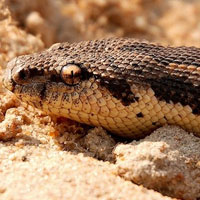
This is because this is where you find one of their favourite foods - frogs. Tiger snakes numbers seem to have declined in recent years. Tiger Snakes are often found in close proximity to water sources. The Common Tiger Snake is found in Victoria and southern New South Wales, extending up into south-eastern Queensland. Notechis scutatus or the Common Tiger Snake Up to 90 Western Tiger snake young can be produced in a single litter, but between 10 and 30 is a more common litter size.Where in Australia Western Tiger Snake are found: Like the other tiger snake subspecies, western tiger snakes produce live young.When the Western Tiger Snake feels threatened they flatten their neck out to make themselves look bigger.Like all members of the Tiger Snake group, this subspecies is capable of delivering a fatal bite to a human.The stunning yellow pattern is typical of western tiger snakes.Up to 90 young can be produced in a single litter, but between 10 and 30 is a more common litter size. When they feel threatened they flatten their neck out to make themselves look bigger. Like the other Tiger Snake subspecies, Western Tiger Snakes produce live young. The Western Tiger Snake can get up to about 1.6 metres in length. The Western Tiger Snake shelters in or under fallen and rotting timber, in abandoned animal burrows, and under rocks and dense vegetation. Like all members of the Tiger Snake group, this subspecies is capable of delivering a fatal bite to a human.Īdults hunt for frogs, lizards, small mammals, and nesting birds during the day and evening, and are known to hunt for frogs on wet nights.

The stunning yellow pattern is typical of the Western Tiger Snake. Western Tiger Snake is common over most of its range in south-western Western Australia. Notechis scutatus occidentalis or the Western Tiger Snake Inland Taipan uses the 'snap and release' technique when hunting rats to avoid being bitten by their prey when they've envenomated it. Where in Australia Inland Taipan can be seen: The only recorded bites from the inland taipan are to people who keep the species. In fact, this animal was only recognised as a taipan in 1974. The inland taipan is seldom seen by humans.An average bite from an adult inland taipan is enough to kill 250,000 mice.It is 50 times more lethal than the venom of the Indian Cobra. The inland taipan has the world's most toxic snake venom.The Inland Taipan is an egg layer, depositing 10 to 18 eggs deep underground during the summer months. In the wild their lives revolve around rat plagues - feast, breed and then die back with the next famine. The only recorded bites from the Inland Taipan come from keepers, but there has never been a human fatality. It knows once its venom is delivered, it will be only a short time to wait for its victim to die and be ready for eating. This is the reason Taipans use the 'snap and release' technique. Having powerful venom is of little consequence if the prey item you've just sunk your fangs into turns and snaps your neck with one bite of its jaws. The Inland Taipan needs to be careful when hunting rats. The snakes shelter in the deep cracks in the ground, where the temperature drops by up to 18 degrees Celcius. The Inland Taipan is seldom seen by humans, in fact this animal was only recognised as a Taipan in 1974. In the areas where these animals live, summer ground temperatures often exceed 50 degrees Celcius.

Strongly neurotoxic and has been shown to produce presynaptic ultrastructural changes in the rat diaphragm, preventing the animal from breathing. An average bite from an adult Inland Taipan is enough to kill 250,000 mice. This venom is The world's most toxic snake venom belongs to the animal you are now looking at. Oxyuranus microlepidotus or the Inland Taipan


 0 kommentar(er)
0 kommentar(er)
